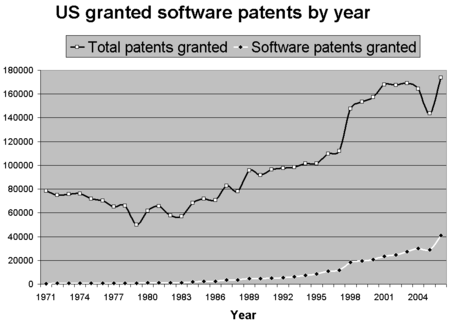Bessen/Hunt technique

The Bessen/Hunt technique is a way of identifying software patents within the patent database of the United States Patent and Trademark Office (USPTO) by using keyword searching. It was proposed by James Bessen and Robert M. Hunt in a 2004 working paper discussing the impact of software patents on research and development.[1]
Publication
Bessen and Hunt's working paper was published in 2004[1] while the debate in Europe concerning the proposed directive on the patentability of computer-implemented inventions was ongoing and received attention from various commentators.[2][3][4]
The completed paper was published in 2007[5] but has not received the same attention.
Details
The technique proposed by Bessen and Hunt involves conducting a keyword search within the USPTO patent database as follows:
- (("software" in specification) OR ("computer" AND "program" in specification))
- AND (utility patent excluding reissues)
- ANDNOT ("chip" OR "semiconductor" OR "bus" OR "circuit" OR "circuitry" in title)
- ANDNOT ("antigen" OR "antigenic" OR "chromatography" in specification)
An actual query that may be submitted to the USPTO database to retrieve patents granted in 2005 is as follows:[6]
- ISD/(1/1/2005->1/1/2006)
- AND SPEC/(software OR (computer AND program))
- AND APT/1
- ANDNOT TTL/(chip OR semiconductor OR bus OR circuit OR circuitry)
- ANDNOT SPEC/(antigen or antigenic OR chromatography)
Proponents
This technique is used by the Public Patent Foundation to track software patents granted by the USPTO and shows that the number of software patents being granted is generally increasing year on year.[2]
Critics
Robert Hahn and Scott Wallsten of the American Enterprise Institute wrote a paper in November 2003 directly criticising the Bessen/Hunt technique.[3] Bessen and Hunt wrote a reply in 2004.[7]
A 2006 paper by Michael Noel and Mark Schankerman of the London School of Economics and Political Science also mentions the Bessen/Hunt technique and suggests that keyword searching can be difficult since many patent applications may contain the word software or other related words but not be primarily about software itself.[4] Noel and Schankerman instead define a software patent as any patent classified by the (European) Patent Office in International Patent Classication G06F ('Electric Digital Data Processing').
See also
| Computer programs, software and patent law | |
 | |
| Topics | |
|---|---|
| Treaties | |
|
TRIPS Agreement | |
| Countries | |
| Case law | |
| Related topics | |
References
- 1 2 An Empirical Look at Software Patents Working Paper No. 03-17/R by James Bessen and Robert M. Hunt
- 1 2 The Public Patent Foundation website provides regular updates on the number of patents being granted using a technique similar to the Bessen/Hunt technique but which does not exclude re-examinations and design patents
- 1 2 A Review of Bessen and Hunt's Analysis of Software Patents, November 2003, Robert Hahn and Scott Wallsten, American Enterprise Institute
- 1 2 CEP Discussion Paper No 740, August 2006, Strategic Patenting and Software Innovation by Michael Noel and Mark Schankerman, London School of Economics and Political Science
- ↑ James Bessen and Robert M. Hunt (2007), “An Empirical Look at Software Patents,” Journal of Economics and Management Strategy 16, no. 1, pp. 157-89
- ↑ USPTO Tips on Fielded Searching
- ↑ A Reply to Hahn and Wallsten by Bessen and Hunt, 2004